Summary: A new study may help to increase understanding of Duchenne muscular dystrophy.
Source: Binghampton University.
Severity of disease tied to gene that modulates the immune system.
A new paper, co-written by faculty at Binghamton University, State University of New York, increases the understanding of Duchenne muscular dystrophy (DMD)–one of the most common lethal genetic disorders–and points to potential therapeutic approaches.
“The findings suggest that the immune system has an important role in the muscle disease of Duchenne muscular dystrophy,” said Eric Hoffman, professor of pharmaceutical sciences and associate dean for research at Binghamton University’s School of Pharmacy and Pharmaceutical Sciences.
DMD, the most common of many types of muscular dystrophy, generally occurs in young boys, where they first show signs of muscle weakness in early school years. The disease then gradually destroys muscle tissue, so that boys lose the ability to walk in their early-mid teens, and then later succumb to respiratory or cardiac failure. All patients with DMD have gene mutations in the dystrophin gene so that they do not make dystrophin protein in muscle tissue. The dystrophin gene is the largest gene in the human genome; lack of dystrophin protein was discovered as the cause of DMD by Hoffman in 1987.
While all DMD patients share the same genetic and protein problem in muscle, they often show differences in the severity of their disease. Some are particularly severe (losing ambulation at just 8 or 9 years of age), whereas others are much less severe (walking until their 20s).
Hoffman and his colleagues sought to determine why different DMD patients responded differently to the same loss of the dystrophin protein in their muscle. After studying hundreds of DMD patients, they confirmed that the gene CD40, an important modulator of the immune system, held a polymorphism that modified the severity of Duchenne muscular dystrophy. Polymorphisms are subtle differences in genes that dictate the color of hair, height, skin color and many other aspects that make each person unique.

NeuroscienceNews.com image is for illustrative purposes only.
“Slight differences in the immune system lead to different reactions regarding the muscular dystrophy. The immune system needs to be balanced: too much or too little is a bad thing in any immune response. This balance may be shifted in muscular dystrophy due to the CD40 polymorphism,” said Hoffman.
“If a genetic polymorphism of CD40 leads to milder disease in DMD, then it follows that drugs targeting CD40 may also improve patient symptoms,” added Hoffman. “This research opens new therapeutic avenues to try to develop therapies for DMD.”
Source: Eric Hoffman – Binghampton University
Image Source: NeuroscienceNews.com image is in the public domain.
Original Research: Abstract for “Association Study of Exon Variants in the NF-κB and TGFβ Pathways Identifies CD40 as a Modifier of Duchenne Muscular Dystrophy” by Luca Bello, Kevin M. Flanigan, Robert B. Weiss, show United Dystrophinopathy Project, Pietro Spitali, Annemieke Aartsma-Rus, Francesco Muntoni, Irina Zaharieva, Alessandra Ferlini, Eugenio Mercuri, Sylvie Tuffery-Giraud, Mireille Claustres, Volker Straub, Hanns Lochmüller, Andrea Barp, Sara Vianello, Elena Pegoraro, Jaya Punetha, Heather Gordish-Dressman, Mamta Giri, Craig M. McDonald, Eric P. Hoffman, and Cooperative International Neuromuscular Research Group in American Journal of Human Genetics. Published online October 13 2016 doi:10.1016/j.ajhg.2016.08.023
[cbtabs][cbtab title=”MLA”]Binghampton University. “Increasing Understanding of Duchenne Muscular Dystrophy.” NeuroscienceNews. NeuroscienceNews, 13 October 2016.
<https://neurosciencenews.com/duchenne-understanding-immune-system-5293/>.[/cbtab][cbtab title=”APA”]Binghampton University. (2016, October 13). Increasing Understanding of Duchenne Muscular Dystrophy. NeuroscienceNews. Retrieved October 13, 2016 from https://neurosciencenews.com/duchenne-understanding-immune-system-5293/[/cbtab][cbtab title=”Chicago”]Binghampton University. “Increasing Understanding of Duchenne Muscular Dystrophy.” https://neurosciencenews.com/duchenne-understanding-immune-system-5293/ (accessed October 13, 2016).[/cbtab][/cbtabs]
Abstract
Association Study of Exon Variants in the NF-κB and TGFβ Pathways Identifies CD40 as a Modifier of Duchenne Muscular Dystrophy
The expressivity of Mendelian diseases can be influenced by factors independent from the pathogenic mutation: in Duchenne muscular dystrophy (DMD), for instance, age at loss of ambulation (LoA) varies between individuals whose DMD mutations all abolish dystrophin expression. This suggests the existence of trans-acting variants in modifier genes. Common single nucleotide polymorphisms (SNPs) in candidate genes (SPP1, encoding osteopontin, and LTBP4, encoding latent transforming growth factor β [TGFβ]-binding protein 4) have been established as DMD modifiers. We performed a genome-wide association study of age at LoA in a sub-cohort of European or European American ancestry (n = 109) from the Cooperative International Research Group Duchenne Natural History Study (CINRG-DNHS). We focused on protein-altering variants (Exome Chip) and included glucocorticoid treatment as a covariate. As expected, due to the small population size, no SNPs displayed an exome-wide significant p value (< 1.8 × 10−6). Subsequently, we prioritized 438 SNPs in the vicinities of 384 genes implicated in DMD-related pathways, i.e., the nuclear-factor-κB and TGFβ pathways. The minor allele at rs1883832, in the 5′-untranslated region of CD40, was associated with earlier LoA (p = 3.5 × 10−5). This allele diminishes the expression of CD40, a co-stimulatory molecule for T cell polarization. We validated this association in multiple independent DMD cohorts (United Dystrophinopathy Project, Bio-NMD, and Padova, total n = 660), establishing this locus as a DMD modifier. This finding points to cell-mediated immunity as a relevant pathogenetic mechanism and potential therapeutic target in DMD. "Association Study of Exon Variants in the NF-κB and TGFβ Pathways Identifies CD40 as a Modifier of Duchenne Muscular Dystrophy” by Luca Bello, Kevin M. Flanigan, Robert B. Weiss, show United Dystrophinopathy Project, Pietro Spitali, Annemieke Aartsma-Rus, Francesco Muntoni, Irina Zaharieva, Alessandra Ferlini, Eugenio Mercuri, Sylvie Tuffery-Giraud, Mireille Claustres, Volker Straub, Hanns Lochmüller, Andrea Barp, Sara Vianello, Elena Pegoraro, Jaya Punetha, Heather Gordish-Dressman, Mamta Giri, Craig M. McDonald, Eric P. Hoffman, and Cooperative International Neuromuscular Research Group in American Journal of Human Genetics. Published online October 13 2016 doi:10.1016/j.ajhg.2016.08.023






